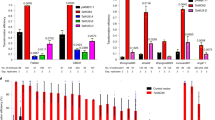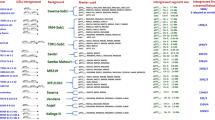Abstract
We have established an efficient protocol for plant regeneration from haploid Indica-type rice protoplasts. Incubation of these protoplasts with the selectable hygromycin phosphotransferase (hph) gene expressed under control of the 35S promoter of cauliflower mosaic virus (CaMV) and polyethyleneglycol (PEG), and subsequent culture in the presence of hygromycin B, led to the recovery of numerous resistant clones from which 77 plants were regenerated. Data from Southern analysis and enzyme assays proved that the transgene was stably integrated into the host genome and expressed, and that it was inherited in offspring.
This is a preview of subscription content, access via your institution
Access options
Subscribe to this journal
Receive 12 print issues and online access
$209.00 per year
only $17.42 per issue
Buy this article
- Purchase on Springer Link
- Instant access to full article PDF
Prices may be subject to local taxes which are calculated during checkout
Similar content being viewed by others
References
Khush, G.S. 1984. IRRI breeding program and its worldwide impact on increasing rice production, p. 61–94 In: Gene Manipulation in Plant Improvement. Gustafson, J.P. (Ed.). Plenum Press, NY.
Swaminathan, M.S. 1982. Biotechnology research and third world agriculture. Science 218: 967–972.
Potrykus, I. 1990. Gene transfer to cereals: An assessment. Bio/Technology 8: 535–542.
Paszkowski, J., Shillito, R.D., Saul, M.W., Mandak, V., Hohn, T., Hohn, B. and Potrykus, I. 1984. Direct gene transfer to plants. EMBO J 3: 2717–2722.
Potrykus, I. 1990. Gene transfer to plants: assessment and perspectives. Physiol. Plant. 73(1), In press.
Vasil, I.K. 1988. Progress in the regeneration and genetic manipulation of cereal crops. Bio/Technology 6: 397–402.
Datta, S.K., Datta, K. and Potrykus, I. 1990. Embryogenesis and plant regeneration from microspores of both “Indica” and “Japonica” rice (Oryza sativa). Plant Sci. 67: 83–88.
Datta, S.K., Datta, K. and Potrykus, I. 1990. Fertile Indica rice plants from protoplasts of microspore derived suspension culture. Plant Cell Rep. In press.
Chu, C.C., Wang, C.C., Sun, S.S., Hsu, C., Yin, K.C., Chu, C.Y. and Bi, F.Y. 1975. Establishment of an efficient medium for anther culture of rice through comparative experiments on the nitrogen sources. Sci. Sin. 18: 659–668.
Murashige, T. and Skoog, F. 1962. A revised medium for a rapid growth and bioassay with tobacco tissue culture. Physiol. Plant. 15: 473–479.
Southern, E.M. 1975. Detection of specific sequences among DNA fragments separated by gel electrophoresis. J. Mol. Biol. 98: 503–517.
Toriyama, K., Arimoto, Y., Uchimiya, H. and Hinata, K. 1988. Transgenic rice plants after direct gene transfer into protoplasts. Bio/Technology 6: 1072–1074.
Zhang, W. and Wu, R. 1988. Efficient regeneration of transgenic rice plants from rice protoplasts and correctly regulated expression of foreign genes in the plants. Theor. Appl. Genet. 76: 835–840.
Zhang, H.M., Yang, H., Rech, E.L., Golds, T.J., Davis, A.S., Mulligan, B.J., Cocking, E.C. and Davey, M.R. 1988. Transgenic rice plants produced by electroporation-mediated plasmid uptake into protoplasts. Plant Cell Rep. 7: 379–384.
Shimamoto, K., Terada, R., Izawa, T. and Fujimoto, H. 1989. Fertile transgenic rice plants regenerated from transformed protoplasts. Nature 338: 274–277.
Fromm, M.E., Taylor, L.P. and Walbot, W. 1986. Stable transformation of maize after gene transfer by electroporation. Nature 319: 791–793.
Rhodes, C.A., Pierce, D.A., Mettler, D.M., Mascarenhas, D. and Detmer, J.J. 1988. Genetically transformed maize plants from protoplasts. Science 240: 204–207.
Lee, L., Schroll, R.E., Grimes, H.D. and Hodges, T.K. 1989. Plant regeneration from indica rice (Oryza sativa) protoplasts. Planta 178: 325–333.
Peterhans, A., Datta, S.K., Datta, K., Godali, G.J., Potrykus, I. and Paszkowski, E. 1990. Recognition efficiency of Dicotyledoneae specific promoter and RNA processing signals in rice. Mol. Gen. Genet. In press.
Potrykus, I., Paskowski, J., Saul, M.W., Petruska, J. and Shillito, R.D. 1985. Molecular and general genetics of a hybrid foreign gene introduced into tobacco by direct gene transfer. Mol. Gen. Genet. 199: 167–177.
Blochinger, K. and Diggelmann, H. 1984. Hygromycin B phosphotransferase as a selectable marker for DNA transfer experiments with higher eucaryotic cells. Mol. Cell. Biol. 4: 2929–2931.
Schocher, R.J., Shillito, R.D., Saul, M.W., Paskowski, J. and Potrykus, I. 1986. Co-transformation of unlinked foreign genes into plants by direct gene transfer. Bio/Technology 4: 1093–1096.
Delanny, X., LaVallee, B.J., Proksch, R.K., Fuchs, R.L., Sims, S.R., Greenplate, J.T., Marrone, P.G., Dodson, R.B., Augustine, J.J., Layton, J.G. and Fischhoff, D.A. 1989. Field performance of transgenic tomato plants expressing the Bacillus thuringiensis var. kurstaki insect control protein. Bio/Technology 7: 1265–1269.
Gronenborn, B. 1989. The molecular biology of cauliflower mosaic virus and its application as plant gene vector, p. 1–29. In: Plant DNA Infectious Agents. Hohn T. H. and Schell J. (Eds.). Springer-Verlag, Wien, NY.
Pietrzak, M., Shillito, R.D., Hohn, T. and Potrykus, I. 1986. Expression in plants of two bacterial antibiotic resistance genes after protoplast transformation with a new plant expression vector. Nucleic Acid Res. 14: 5857–5868.
Negrutiu, I., Shillito, R., Potrykus, I., Biasini, G. and Sala, F. 1987. Hybrid genes in the analysis of transformation condition. Plant Mol. Biol. 8: 363–373.
Shillito, R.D., Paskowski, J. and Potrykus, I. 1983. Agarose plating and a bead type culture technique enable and stimulate development of protoplasts-derived colonies in a number of plant species. Plant Cell Rep. 2: 244–247.
Murray, H.G. and Thompson, W.F. 1980. Rapid isolation of high molecular weight plant DNA. Nucleic Acid Res. 8: 4321–4326.
Feinberg, A.P. and Vogelstein, B. 1983. A technique for radiolabelling DNA restriction endonuclease fragments to high specific activity. Anal. Biochem. 132: 6–13.
Cabanes-Bastos, E., Day, A.G. and Lichtenstein, C.P. 1989. A sensitive and simple assay for neomycin-phosphotransferase II activity in transgenic tissue. Gene 77: 169–177.
Author information
Authors and Affiliations
Rights and permissions
About this article
Cite this article
Datta, S., Peterhans, A., Datta, K. et al. Genetically Engineered Fertile Indica-Rice Recovered from Protoplasts. Nat Biotechnol 8, 736–740 (1990). https://doi.org/10.1038/nbt0890-736
Received:
Accepted:
Issue Date:
DOI: https://doi.org/10.1038/nbt0890-736
This article is cited by
-
Influence of exogenous polyamines on somatic embryogenesis and regeneration of fresh and long-term cultures of three elite indica rice cultivars
Cereal Research Communications (2021)
-
Pyramiding of three C4 specific genes towards yield enhancement in rice
Plant Cell, Tissue and Organ Culture (PCTOC) (2017)
-
Expression of chimeric Bt gene, Cry1Aabc in transgenic pigeonpea (cv. Asha) confers resistance to gram pod borer (Helicoverpa armigera Hubner.)
Plant Cell, Tissue and Organ Culture (PCTOC) (2016)
-
Genetic transformation of cultivated sesame (Sesamum indicum L. cv Rama) through particle bombardment using 5-day-old apical, meristematic tissues of germinating seedlings
Plant Cell, Tissue and Organ Culture (PCTOC) (2015)
-
Genetic transformation of cultivated jute (Corchorus capsularis L.) by particle bombardment using apical meristem tissue and development of stable transgenic plant
Plant Cell, Tissue and Organ Culture (PCTOC) (2015)



